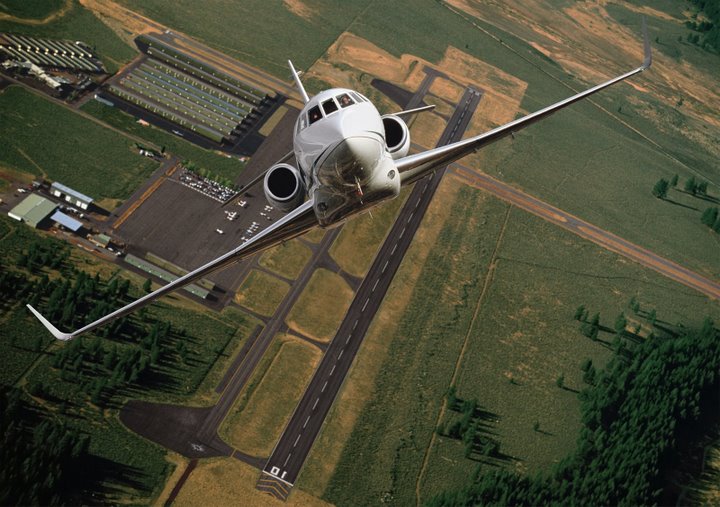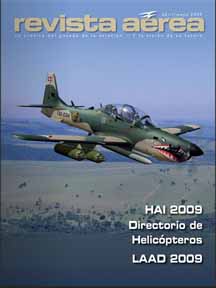Revista Aerea – Abril/Mayo ’09
April 30, 2009
Bell Helicopter Sells 24 Model 407 Helicopters Destined for Iraqi Air Force
April 30, 2009
FORT WORTH, TEXAS (April 29, 2009) – Bell Helicopter, a Textron Inc. (NYSE: TXT) company, today announced that the U.S. Army has awarded the company a $60.3 million contract for 24 of its Model 407 helicopters, which the Army will provide to the Iraqi Air Force as part of a planned Foreign Military Sale to Iraq.
The Iraqi Ministry of Defense has selected the Bell Model 407 as the basis for a new Iraqi Air Force armed scout helicopter. Initial aircraft deliveries to the U.S. Army are expected to begin later this year. The 24 Model 407 helicopters, built at Bell’s commercial aircraft manufacturing facility in Mirabel, Canada, will be militarized by the U.S. Army to meet Iraqi Air Force requirements.
In February, the U.S. Army purchased three Model 407s from Bell that are currently being used as prototype aircraft for the development and testing of military-unique modifications. Once the Army has finished qualification with the initial prototype aircraft, military-unique modifications will then be applied to these 24 production aircraft before they are delivered to the Iraqi Air Force.
The Model 407 is Bell Helicopter’s most popular commercial product and has accumulated more than 2.3 million hours of proven commercial service in a variety of configurations, including law enforcement, medical evacuation, offshore support and executive transport.
Dassault’s Falcon 2000LX Awarded EASA and FAA Certification
April 30, 2009

(Saint-Cloud, France, April 30, 2009) – Dassault Falcon announced today that the newest
member of the Falcon family of business jets, the 4000 nm Falcon 2000LX, has received
certification from the FAA. EASA certification was granted on April 23rd. The first
delivery will be made in early May.
“The Falcon 2000LX offers the lowest operating costs of any airplane in the large cabin
class and is an ideal solution for today’s challenging economic times,” said John
Rosanvallon, President and CEO of Dassault Falcon. “It’s the most fuel efficient airplane
in the large cabin class which means a lower fuel bill and lower fuel emissions. It can
land and depart from short airfields so you can land closer to your destination and beat
your competition to grow your business.” The Falcon 2000LX is even more fuel efficient
than smaller airplanes including the newest of mid-sized business jets.
The 4,000 nm range 2000LX offers the same spacious, quiet interior as the 2000EX
EASy but the capability to serve a more extensive city pairs. The 2000LX will be able to
connect New York to Moscow; Paris to Mumbai; Dubai to London and Hong Kong to
Brisbane non stop. It also offers a 10 to 15% climb speed improvement (over the Falcon
2000EX) allowing it to reach 41,000 ft in just 18 minutes. The Falcon 2000LX comes
standard with the award-winning EASy flight deck which has won high marks and praise
for its integrated features and intuitive displays
Joint Efforts
The 2000LX program involved the joint efforts of Dassault Falcon and Aviation Partners
Inc. in Seattle, Washington. Dassault is responsible for new production aircraft while
Aviation Partners, the owner of the FAA Supplemental Type Certificate, is responsible
for the retrofit of in-service Falcon 2000 aircraft
API developed this High-Mach Blended Winglet specifically for the already-optimized
Dassault Falcon wing design. Modifications such as reinforcing straps on the upper and
lower wing panels and servo actuator door to accommodate the increased loads were
needed. The final result is a baseline wingspan for the 2000LX that is six feet nine inches
longer than the 2000EX while adding minimal weight.
The Falcon 2000LX is powered by the same highly reliable Pratt & Whitney Canada
PW308C engines as the 2000EX. The PW308C is rated at 7,000lbs thrust (ISA + 15C)
and recently passed 220,000 flight hours on the Falcon fleet.
Delivery of the 900th PC-12
April 30, 2009
Pilatus Aircraft is pleased to announce a major program milestone today
with the delivery of the 900th PC-12. At a celebration at the company’s
US headquarters in Broomfield, Colorado, owner Ron Roma accepted the
keys to his new aircraft from Pat Epps, President of Epps Aviation, the
factory authorized Pilatus Center for the southeastern United States
based in Atlanta, Georgia.
Roma, who has owned no less than four new PC-12s previously, not only
has the distinction of owning the milestone aircraft, a brand new 2009
PC-12 NG, but also for taking delivery of his 5th new PC-12 from Pilatus.
Roma explained, “Why do I keep coming back? I’ve flown PC-12s for
many years now on personal flights with my family and for business. I
have flown all over the United States and around the world twice in them.
The aircraft is extremely solid and reliable. Pilatus engineering just nailed
it when they originally designed it and since then they have made very
thoughtful improvements over the years. The PC-12 is just a great thing
that keeps getting better, and now I’ll have the latest with the
PC-12 NG.”
Thomas Bosshard, President and CEO of Pilatus Business Aircraft, Ltd.,
added, “Ron has been a tremendous customer to Pilatus and it’s
impossible to overstate how much we appreciate his business. The 900th
delivery is a very proud moment in the PC-12 program, which is why we
are so pleased to deliver this milestone aircraft to him. He will certainly
put it to work, and we are anxious to hear about the new
adventures he’ll have in his PC-12 NG.”
Featuring a number of significant improvements over its predecessor,
including the fully integrated Honeywell Primus Apex avionics system, a
completely new cockpit designed by BMW Group DesignworksUSA, and a
more powerful Pratt & Whitney Canada PT6A engine, the PC-12 NG
provides operators with a cost effective, efficient, and reliable solution to
meet transportation needs in today’s demanding economy.
Thales announces a world first in air navigation
April 30, 2009
EASA certifies Thales’s primary reference ADU
AAAA, Nashville, 30 April 2009 – Thales announced today it has received ETSO C106
certification from the European Aviation Safety Agency (EASA) for its primary reference Air
Data Unit 3200 for helicopters.
A key component of any navigation system, Thales’s ADU 3200 is capable of generating
primary flight information such as altitude, airspeed and temperature by measuring static
pressure, total pressure and temperature. This flight safety system for helicopters offers an
exceptional reliability of 14,500 flight hours.
Packed with high-tech
The compact, lightweight ADU 3200 boasts many innovations. For example, it is the only
ADU on the market employing algorithmic processing to eliminate errors due to helicopter
blade rotation. Integrating high-precision sensors, the ADU 3200 delivers excellent
performance when measuring low speeds (up to 20Kts), a feature much appreciated by
helicopter operators.
World first
To optimise development time, Thales used object-oriented technologies and Agile software
development methodologies. “Employing these innovative methodologies in order to obtain
the highest DO178B level A certification for the ADU 3200 is a world first,” said Yves
Joannic, Thales’s Vice President for Helicopter Solutions.
Thales’s ADU 3200 has been selected as original equipment on the following helicopters:
Sikorsky S-76D; Eurocopter EC135, 145, 155, 225, 635 and 725; UH-72A Lakota; and
Agusta A109 LUH.
CAE concludes fiscal year 2009 with record order intake over C$1 billion for Military segments
April 30, 2009
CAE awarded military contracts in fourth quarter valued at over C$540 million
MONTREAL, QUEBEC–(Marketwire – April 30, 2009) – (TSX:CAE)(NYSE:CGT) CAE has ended fiscal year 2009 (April 1, 2008 to March 31, 2009) with record order activity in its military segments. Order intake for CAE’s military segments totaled C$1.09 billion, including more than C$540 million in the fourth quarter alone. The total order intake represents a 47 per cent increase over the last fiscal year and the largest annual military order intake in the Company’s history.
“Our strong military business and our diversification across regions, products and services have enhanced CAE’s position in the current environment,” said Marc Parent, CAE’s Chief Operating Officer. “As more militaries and governments look to an increased use of simulation and synthetic training, the defence market continues to be positive for CAE as demonstrated by our record order intake for fiscal year 2009.”
Some of the key orders this fiscal year include a contract from the Government of Canada for C-130J aircrew training, a contract extension with the Commonwealth of Australia to continue providing training support services through 2018, and a contract to develop Hawk 128 full-mission simulators for the U.K.’s Military Flying Training System (MFTS) program. Rotorsim, the consortium owned equally by CAE and AgustaWestland, signed contracts with the Netherlands Ministry of Defence for comprehensive NH90 helicopter training systems and services. Fiscal year 2009 also saw Helicopter Flight Training Services (HFTS), a consortium owned equally by CAE, Eurocopter, Thales and Rheinmetall Defence Electronics, inaugurate NH90 training at the German Army Aviation School in Bueckeburg.
In the US military market, CAE USA won contracts with all branches of the US services, including a series of contracts with the United States Navy to design and manufacture MH-60S/R simulators and additional contract options to continue development and services as part of the Synthetic Environment Core (SE Core) program for the US Army. During the fourth quarter, CAE was awarded a contract from the US Army Program Executive Office for Simulation, Training, and Instrumentation (PEO STRI) to perform upgrades to the MH-60L Black Hawk and MH-47G Chinook combat mission simulators (CMS) operated by the 160th Special Operations Aviation Regiment – Airborne. CAE will convert the MH-60L simulator to the newest variant of the Black Hawk helicopter called the MH-60M, and will update the MH-47G CMS with aircraft survivability equipment and other new functionalities.
CAE is a world leader in providing simulation and modelling technologies and integrated training solutions for the civil aviation industry and defence forces around the globe. With annual revenues exceeding C$1.4 billion, CAE employs approximately 7,000 people at more than 75 sites and training locations in 20 countries. We have the largest installed base of civil and military full-flight simulators and training devices. Through our global network of 27 civil aviation and military training centres, we train more than 75,000 crewmembers yearly. We also offer modelling and simulation software to various market segments and, through CAE’s professional services division, we assist customers with a wide range of simulation-based needs.
GOL Lança Novos Voos a Partir do Aeroporto Santos Dumont
April 30, 2009
São Paulo, 30 de abril de 2009 – A GOL Linhas Aéreas Inteligentes
S.A. (Bovespa: GOLL4 e NYSE: GOL), a companhia aérea brasileira de
baixo custo, anuncia que recebeu autorização da Agência Nacional de
Aviação Civil (Anac) para operar voos regulares a partir do Aeroporto
Santos Dumont (Rio de Janeiro) com destino a Belo Horizonte
(Confins), Brasília e Vitória.
A operação para Vitória já começou. São cinco frequências diárias,
sendo que três operam de segunda-feira a sábado e outras duas atendem
a rota todos os dias. Um desses voos liga o Aeroporto Santos Dumont a
Manaus, com escalas em Vitória e Brasília. A operação é a única no
mercado entre Vitória e a capital amazonense com decolagem diurna e
sem necessidade de conexão. Outro voo irá ligar Santos Dumont a
Manaus via Brasília, totalizando duas ligações diárias entre o
aeroporto central da capital carioca e a cidade amazonense, além das
duas já existentes ligações diárias entre o Aeroporto Internacional
do Rio de Janeiro – Antônio Carlos Jobim/Galeão e Manaus.
A GOL também vai servir Belo Horizonte (Confins) e Brasília com voos
diretos do Aeroporto Santos Dumont, a partir do dia 4 de maio de
2009. Os destinos constituem dois dos principais hubs de distribuição
da Companhia no Brasil, permitindo conexões imediatas para cidades
como Salvador, Cuiabá, Goiânia, Palmas, Belém, Recife, Macapá, Boa
Vista, São Luis, Marabá, entre outras.
Galeão
Além dos novos voos a partir do Santos Dumont, a GOL mantém forte sua
operação entre o Galeão e as cidades de Belo Horizonte, Brasília e
Vitória. A Companhia oferece seis voos diários para a capital
federal, quatro para Confins e dois para a capital capixaba (sendo que
um terceiro será lançado no dia 15 de maio de 2009).
GOL Introduces New Routes From Santos Dumont Airport
April 30, 2009
SAO PAULO, April 30 /PRNewswire-FirstCall/ — GOL Linhas Aereas Inteligentes S.A. (Bovespa: GOLL4 and NYSE: GOL), Brazil’s low-cost airline, announces that it has received approval from Anac, the Brazilian civil aviation authority, to operate regular flights from Santos Dumont airport (Rio de Janeiro) to Belo Horizonte (Confins airport), Brasilia and Vitoria.
Flights to Vitoria have begun with five daily frequencies, three of which operate Monday through Saturday, two other frequencies operate daily. One of the daily flights connects Santos Dumont airport and Manaus, after stopovers in Vitoria and Brasilia. This is the only daytime, nonstop flight between Vitoria and Manaus. The second daily flight connects Santos Dumont and Manaus via Brasilia, bringing the total connections between Rio de Janeiro and the Amazonas state capital to two in addition to existing daily connections between the Rio de Janeiro’s Galeao airport and Manaus.
Beginning May 4, 2009, GOL will launch direct flights from Santos Dumont airport to Belo Horizonte (Confins) and Brasilia, two of the Company’s principal distribution hubs in Brazil, which will permit quick connections to cities across the country, including Salvador, Cuiaba, Goiania, Palmas, Belem, Recife, Macapa, Boa Vista, Sao Luis and Maraba.
Galeao
In addition to the new flights from Santos Dumont, GOL also offers several flight options between Galeao and Belo Horizonte, Brasilia and Vitoria. The Company offers six daily flights to Brasilia, four daily flights to Confins (Belo Horizonte) and two daily flights to Vitoria, though a third frequency will be available beginning May 15, 2009.
Greenjets Launches Shared-Ride Private Jet Service
April 30, 2009
The Greenjetcard available in Blue, Silver, Gold and Black Membership levels – features include pay-as-you-go and free companions and free trips with some memberships. |
WEST PALM BEACH, Fla., April 30 /PRNewswire/ — Finally private jet travelers have a way to save a lot of money and be more environmentally responsible. Since the automotive industry executives thrashing for not jet-pooling to the bailout hearings in Washington, private fliers everywhere are seeking a way to maintain the high productivity associated with private jets in a way that is more environmentally, socially and fiscally responsible. Greenjets’ shared-ride private jet service offers the solution.
Greenjets offers two easy ways to access its shared-ride jet service to major markets across the U.S. Clients can simply visit www.flygreenjets.com and book a seat on a private jet through the easy online booking system, or call 1-800-916-JETS to book through live concierge. All requests are followed up by dedicated Travel Specialists who arrange flights according to clients’ needs.
Greenjets also offers the Greenjetcard program, where discounts are available for Blue, Silver, Gold and Black card members. With Greenjetcard limited special offer, membership starts as low as $1,400 for a year, and trip prices from NY-Florida can be as low as $1,800 per person with a Black card. Free trips and free companions are available with some memberships as well. Greenjetcard memberships require no money required on account, so clients pay-as-they-go and avoid the risk and cost associated with tying up capital in a jet-card account. The Greenjetcard provides the most cost effective private jet travel solution available today.
Greenjets service between NY and Florida will begin in June 2009, with booking available immediately. Greenjets service will be available for travel for New York, Chicago, Boston, Washington, Atlanta and South Florida markets in 2009. Throughout 2010 and 2011 twenty-seven markets including Dallas and Houston, Los Angeles, Los Vegas and Phoenix will form part of the Greenjets Shared-Ride Network. Greenjetcard members enjoy concierge charter service anywhere including destinations outside the shared-ride network at cost plus 8% with complete transparency as to cost, equipment and charter operator. Greenjets only uses ARG/US Platinum or Gold rated operators, and already has over 40 jets in the preferred operator network providing travel service to our clients.
Greenjets comes at a time when companies and individuals are looking to save money while maintaining productivity through flying private. Many companies have to make due with fewer employees, and flying private is a proven way to get the most out of executive’s and manager’s time. Greenjets provides an affordable private jet solution, and a practical way to remain environmentally more responsible by reducing the number of jets through flight-sharing. By placing 3 passengers on 1 shared-ride Greenjets eliminates two flights and reduces the CO2, noise, air traffic congestion and fossil fuel burn by 2/3 as well.
It’s a simple idea: Sharing the flight with others reduces the number of jets in the air and the impact on our environment. It also saves everyone time and money. Greenjets is an easy and financially smart way to save time by flying private, and remain environmentally responsible. Greenjets provides an innovative way to make better use of people – a more affordable way to see customers, visit factories, transact business and build relationships. Greenjets does not own or operate aircraft – travel service is provided by FAA part 135 air charter operators who maintain operational control at all times. Greenjets is committed to the highest safety, convenience and comfort standards at the lowest possible cost to you and to the environment.
Honda Aircraft Company Updates HondaJet Program
April 30, 2009
GREENSBORO, N.C., April 30 /PRNewswire/ — Honda Aircraft Company, Inc., today announced important updates to its HondaJet aviation program including revised first flight and delivery timetables for the company’s industry-leading advanced light jet. Ongoing global aerospace industry business challenges have resulted in a delay in receiving critical components for conforming aircraft production, which will result in a new first flight target of January 2010 and projected first customer delivery in the fourth quarter of 2011.
Honda Aircraft Company is partnering with leading aerospace industry suppliers for the manufacture of major subassemblies utilizing proprietary Honda designs and technologies. Delays in delivering some of these critical components to Honda for conforming aircraft production has required a revision in the first flight target for conforming aircraft to January 2010. As a result, first customer delivery, originally scheduled for late 2010, is projected in the fourth quarter of 2011 following completion of FAA flight-testing certification.
“We have been working very closely with our suppliers over the past year in an effort to minimize the effect of the ongoing worldwide economic instability on HondaJet development,” said Michimasa Fujino, Honda Aircraft Company president and CEO. “Unfortunately, we now have no choice but to revise our schedule. We appreciate our customers’ continued trust and their understanding of the challenges we are facing to bring to them the most advanced light jet available.”
Honda Aircraft Company has progressed with the establishment of its new state-of-the-art world headquarters campus in Greensboro, North Carolina, where the HondaJet is being developed and will be manufactured. The campus complex includes a world headquarters building that incorporates all engineering, sales, support, marketing, and administration functions. The recently completed world R&D center on campus features over four acres under roof and houses the ongoing construction of conforming aircraft. The R&D facility also houses the world delivery center for all HondaJet aircraft.
The HondaJet offers superior performance, greater interior space and cargo capacity, higher levels of standard equipment, and significantly lower fuel consumption than any light jet of its size. At $3.9 million, the HondaJet is also priced for much less than its leading light jet competitor. “We are confident we will deliver to our customers the best-performing and best-valued light jet in the industry,” added Fujino.
Ground will be broken this summer on the final phase of campus infrastructure development with construction of the HondaJet production facility. With the completion of the HondaJet production facility, the company’s total world headquarters complex will reach 500,000 sq ft under roof on the 83-acre campus.
“We are moving forward confidently with the HondaJet program with the full backing and strength of our parent, Honda Motor Company. Our production facility will incorporate not only production functions, but also world-class flight training facilities. We will deliver to our customers an aircraft of outstanding quality that will be supported with exceptional sales, service and flight training programs,” said Fujino.
About HondaJet
Honda Aircraft Company, Inc., a wholly owned subsidiary of Honda Motor Company, Ltd., began sales of the advanced and innovative HondaJet in October 2006 in the U.S. and has amassed orders for well over 100 aircraft. The $3.9 million HondaJet is Honda’s first-ever commercial aircraft and lives up to the company’s reputation for dynamic performance together with superior efficiency. The HondaJet proof-of-concept aircraft has accumulated more than 425 flight test hours and attained a top speed of 420 knots (483 mph) and a maximum altitude of 43,000 ft. in flight testing.
The HondaJet incorporates many innovative technological advances in aviation design, including a unique over-the-wing engine-mount configuration that dramatically improves aircraft performance and fuel efficiency by significantly reducing aerodynamic drag in flight. This innovative approach to airframe design also lowers ground-detected noise when overhead and allows for a more spacious cabin and greater cargo capacity. The HondaJet is powered by two highly fuel-efficient GE Honda HF120 turbofan jet engines.
<







